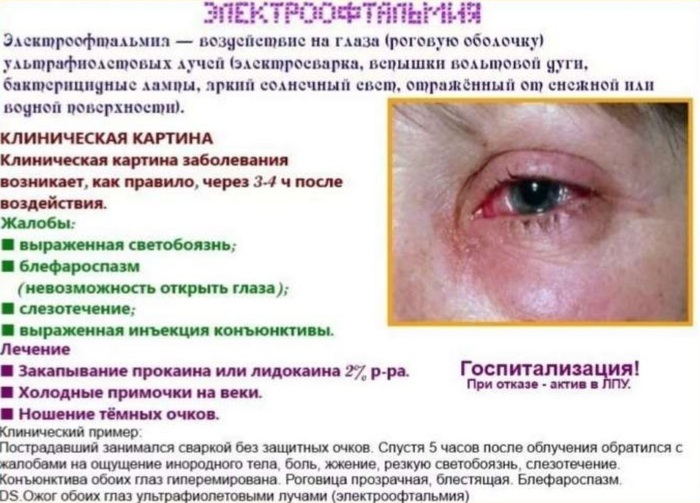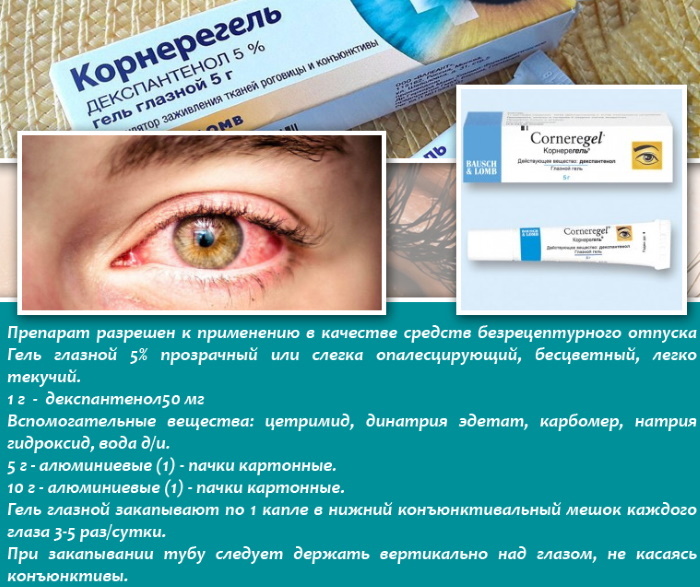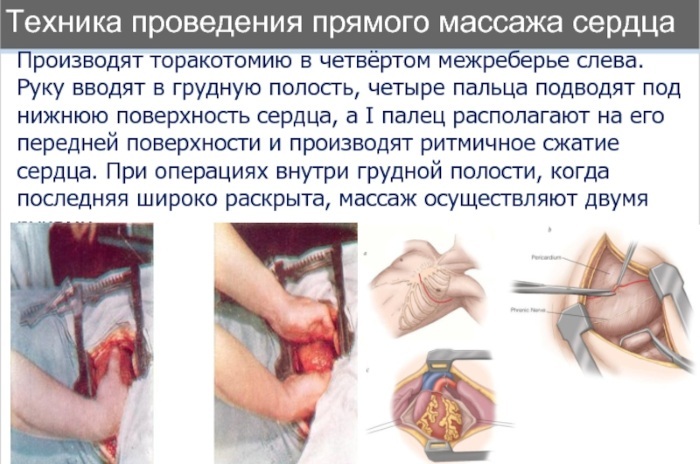Content
- Classification
- Rating
- Fsme-Immun Junior
- Encevir
- Entsepur for children
- Tick-E-Vak
- Tick-borne encephalitis vaccines
Tick-borne encephalitis is a dangerous viral diseasecarried by ixodid ticks. Infection occurs at the time of a bite by a blood-sucking parasite, when its saliva enters the blood and lymphatic fluid of a person. Viral encephalitis always develops rapidly, and the result of this disease is a focal lesion of the central and peripheral nervous system.
From this ailment, paralysis of certain parts of the body occurs, and the risk of death increases. To counteract this disease, vaccines have been developed that stimulate the cells of the human immune system to produce specific antibodies. The price of immunizing drugs starts at 900 rubles. for 1 dose.
Classification
Vaccines against tick-borne encephalitis are produced using the same technology, and also have a similar mechanism of action on the immune system of children and patients of the adult age group. The main difference between these drugs is their different price. The table below lists the classification types of tick-borne encephalitis virus vaccines.
| Classification of vaccines against tick-borne encephalitis | Features of the immunizing agent |
| Domestic | This category of drugs includes vaccines that are produced at Russian pharmaceutical enterprises. The composition of these medicines contains inactivated viral microorganisms that are found in ixodid ticks inhabiting the territory of the Russian Federation, as well as in neighboring countries. An example of domestic medicines are the drugs Encevir, tick-borne encephalitis vaccine cultural. |
| Imported | The imported vaccines against tick-borne encephalitis contain viruses of this disease, the endemic zone of which is the countries of Western Europe. In this case, infectious microorganisms also go through the stage of inactivation with the use of potent chemicals. An example of foreign-made vaccines are Encepur Children's medicines (developed in Germany), as well as Fsme-Immun Junior (Austria). |
Clinical studies show that domestic and Western vaccinations against tick-borne encephalitis contain dead viruses, the genomes of which coincide by 85%. Foreign-made immunizing drugs have fewer contraindications, and also less likely to cause side effects.
Rating
The tick-borne encephalitis vaccine (the price of drugs in this group is available for most people with an average income) is approved for immunization of children of different age groups. The selection of an immunizing drug is carried out by the doctor after a preliminary examination of the patient for medical contraindications.
Fsme-Immun Junior
Preventive medication Fsme-Immun Junior is a vaccine against microorganisms that cause tick-borne encephalitis, which is produced by the Austrian pharmaceutical company Baxter. This drug is available in the form of a suspension with a rich white tint without impurities and signs of precipitation.
Fsme-Immun Junior is intended for intramuscular administration. The active substance of this immunizing agent is the antigen of the virus that causes tick-borne encephalitis. The concentration of the active ingredient is 1.19 μg in 1 dose of suspension (0.25 ml). Fsme-Immun Junior is produced without preservatives and chemicals that have toxic or carcinogenic properties.
Immunizing agent Fsme-Immun Junior is a suspension with a high concentration level, which has undergone high-quality industrial purification from foreign biological impurities. The medication is completely sterile. The composition of this drug contains a strain of the causative agent of tick-borne encephalitis "Neudorfl".
The cells of the viral microorganism were cultured in laboratory conditions on chicken embryos and then rendered harmless using formaldehyde solution. The final stage in the production of viral encephalitis antigen is its sorption using a gel-like substance of aluminum hydroxide.

Fsme-Immun Junior is characterized by a high level of protection, which corresponds to 97-100%. Children of the age group from 1 to 16 years old, who have passed 3 stages of vaccination with this medication, acquire stable immunity from tick-borne encephalitis.
The preventive effect of the drug continues for the next 3 years. During this period of time, the child does not need to be re-vaccinated. In the event of a bite by an ixodid tick, which is a carrier of viral encephalitis, the immune system of children recognizes and then neutralizes the pathogenic microorganism.
Tick-borne encephalitis vaccine (the price of an imported drug is slightly higher than that of Russian-made immunizing agents) Fsme-Immun Junior is indicated for use by children of the age category from 1 to 16 years old, permanently residing in the regions, which are recognized as endemic in the prevalence of this diseases.
Preventive therapy with this medication requires compliance with the following rules of the instruction:
- The vaccine is injected only into the deltoid muscles.
- Shake the syringe several times before using this medication to uniformly mix the suspension.
- For a child under 18 months of age, the drug Fsme-Immun Junior is slowly injected into the outer side of the broad femoral muscle.
- The routine or emergency vaccination procedure should be performed only by a qualified medical professional with the obligatory observance of the standards of sterility and asepsis.
- It is forbidden to administer the drug Fsme-Immun Junior in the form of an intravenous injection, since the ingress of this medication directly into the bloodstream causes anaphylactic shock.
Immunization with Fsme-Immun Junior is performed in several stages. The table below shows the procedure for immunizing children against tick-borne encephalitis using this drug.
| Vaccination sequence | Immunizing dosage | Scheduled vaccination schedule | Emergency suspension scheme |
| First vaccination | 0.25 ml | The drug is injected intramuscularly on the date of the scheduled vaccination. | The patient receives the vaccine immediately on the day of the tick bite. |
| Second vaccination | 0.25 ml | Re-introduction of the immunizing agent is carried out after 1-3 months. | A repeated unscheduled vaccination is carried out 14 days after receiving the first dose of this medication. |
| Third vaccination | 0.25 ml | The third injection must be given no later than 5-12 months later. after the 2nd vaccination. | The final stage of emergency vaccination is repeated administration of the drug after 5-12 months. |
Routine immunization with the prophylactic medication Fsme-Immun Junior is performed from December to April before the start of the active phase of the epidemic season. The third injection with this medication should be made no later than 14 days before traveling to areas that are recognized as a natural source of tick-borne encephalitis. Re-immunization with the drug Fsme-Immun Junior is carried out after 3 years.
The vaccine for children Fsme-Immun Junior has the following contraindications:
- severe allergy to chicken egg protein (children with a similar diagnosis may develop instant anaphylactic shock with the onset of death);
- a state of fever of any etiology;
- infectious diseases of the body with a chronic or acute form of the course;
- individual intolerance to other components that make up the vaccine.

The drug Fsme-Immun Junior is well tolerated by most children of different ages.
Despite this, the manufacturer of this vaccine does not exclude the occurrence of the following side effects:
- redness of the epithelial tissue in the area of the injection;
- enlargement of the submandibular and axillary lymph nodes;
- a change in body temperature upward to 37-38 degrees (a side effect of this type persists for 24 hours);
- development of bronchial spasm;
- swelling of the mucous membranes;
- lowering blood pressure;
- the appearance of a generalized rash, which is accompanied by itching of the skin.
Children with signs of individual intolerance to the Fsme-Immun Junior vaccine should be examined by a pediatrician. Raising the temperature to subfebrile values does not require the use of antipyretic medications. In case of progression of an allergic reaction, antihistamines are used.
The shelf life of the prophylactic agent Fsme-Immun Junior is 30 months. This medication should be stored at a temperature of +2 to 8 degrees Celsius. The suspension cannot be frozen, and its purchase is possible only on the basis of a doctor's prescription. The average cost of the Fsme-Immun Junior vaccination is 2700 rubles. for 1 dose.
Encevir
Encevir is a prophylactic agent for tick-borne encephalitis virus, which is produced by the Russian pharmaceutical company NPO Microgen JSC. This agent is available in the form of a thick suspension for injection into the muscle tissue of the delta. The filling of the medication is carried out in glass ampoules with a capacity of 0.5 ml.
The active substance of the drug Encevir is an antigen of a viral microorganism that is the causative agent of tick-borne encephalitis. One immunizing dose of this agent corresponds to 0.5 ml of suspension. The main packaging of the vaccine is cardboard packs, inside of which there are 3, 5 or 10 ampoules with inactivated virus.
The pharmacological action of the drug Encevir consists in the drug development of humoral and cellular immunity in relation to the causative agent of tick-borne encephalitis. This vaccine provides reliable protection of the body against strains of this virus that circulate in the European and Asian parts of the continent. The Encevir vaccine is indicated for use for routine and emergency prevention of tick-borne encephalitis infection in patients over 3 years old.
The table below shows 2 schemes for vaccination with Encevir:
| Immunization scheme | Dosage regimen |
| Scheme No. 1 | The first vaccination is given on any date appointed by the doctor. The patient is injected intramuscularly with 0.5 ml of the suspension. The second stage of immunization is indicated for carrying out no earlier than after 1-2 months. after the first vaccination. The child receives a standard dose of 0.5 ml. The third vaccination also provides for an intramuscular injection of an inactivated vaccine at a dosage of 0.5 ml. Vaccination is carried out after 12 months. |
| Scheme No. 2 | The first vaccination is performed as scheduled on the day determined by the doctor. The patient receives a dose of 0.5 ml. The second immunization is carried out in 5-7 months. with the introduction of a similar dosage of the drug. The third vaccination must be given no later than 1 year later. |
Subsequent revaccinations with this drug are performed every 3 years. Encevir vaccine is injected into the deltoid muscle tissue. The suspension must not enter the blood vessels. Otherwise, the patient may develop instantaneous anaphylaxis.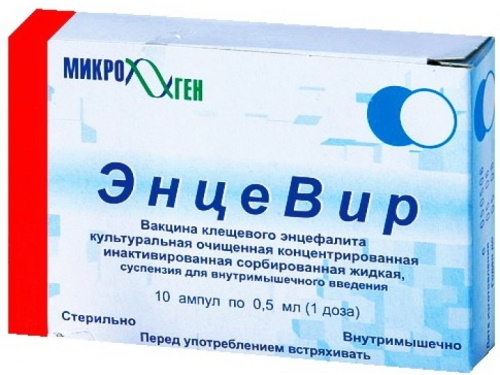
A vaccine against tick-borne encephalitis (the price of a domestically produced drug is slightly lower than that of imported analogues) is used only in the absence of medical contraindications.
The drug Encevir is prohibited for use in the following cases:
- the presence of inflammatory diseases;
- high body temperature, which is kept within 39-40 degrees;
- chronic pathologies of connective tissue;
- epilepsy, accompanied by frequent seizures;
- cancerous tumors, regardless of their location;
- diabetes;
- progressive thyrotoxicosis of the thyroid gland;
- bronchial asthma;
- chicken egg protein allergy;
- exacerbation of diseases with a chronic form of the course, which are associated with an infectious and inflammatory process.
The drug Encevir is approved for simultaneous administration with inactivated suspensions of other types. This product does not contain antibacterial ingredients, preservatives and formaldehyde compounds.
After routine or emergency vaccination with Encevir suspension, the following side effects may occur:
- migraine;
- aches in bones, joints and muscle tissues;
- short-term rise in temperature to 37-38 degrees;
- enlargement of axillary and submandibular lymph nodes;
- redness of the skin in the area of drug administration;
- allergic manifestations, accompanied by a rash, itching of epithelial tissues, edema of the mucous membranes.
In case of manifestation of side properties of this medication, it is necessary to inform the doctor who vaccinated about this fact. The above symptoms can persist for 3-5 days after drug administration.
The shelf life of the Encevir vaccine is 2 years. Storage of the immunizing agent should be carried out at a temperature of +2 to 8 degrees Celsius. You will need a doctor's prescription to buy this drug. The average cost of the Encevir vaccine is from 4280 to 4657 rubles. for a pack of 10 ampoules of 0.5 ml (10 doses).
Entsepur for children
Encepur for children is an inactivated drug for routine and emergency immunization of children against tick-borne encephalitis. This product is produced by the German pharmaceutical company GlaxoSmithKline Vaccines. Encepur for children has the appearance of an opaque thick suspension with a white tint. The active component of this medication is the isolated antigen of the virus (the most common strain of K23), which causes tick-borne encephalitis. The concentration of the basic substance is 0.75 μg per 0.25 ml of suspension (1 prophylactic dose). Packing of vaccinations for children Encepur is carried out in sterile disposable syringes with a needle, made of glass.
The drug Encepur for children is indicated for the prevention of tick-borne encephalitis in children of the age group from 12 months. up to 11 years old. Before immunization, every child is examined by a pediatrician without fail. Children who have reached the age of 12 receive an injection of the adult vaccine.
The table below shows the planned dosage regimen for this medication:
| Vaccination sequence | Prophylactic doses | The time interval between the next injection |
| First dose | 0.25 ml | On the day appointed by the doctor. |
| Second dose | 0.25 ml | After 1-3 months. |
| Third dose | 0.25 ml | After 9-12 months. |
 Scheduled vaccination against tick-borne encephalitis begins in winter or early spring, so that by the beginning of the activity of blood-sucking parasites, the child's body will receive stable immunity. In the case of an ixodid tick bite, an emergency immunization regimen with Encepur for children is used.
Scheduled vaccination against tick-borne encephalitis begins in winter or early spring, so that by the beginning of the activity of blood-sucking parasites, the child's body will receive stable immunity. In the case of an ixodid tick bite, an emergency immunization regimen with Encepur for children is used.
The table below describes the vaccination plan for unvaccinated patients who have been bitten by a tick:
| Vaccination sequence | Prophylactic doses | The time interval between the next injection |
| First injection | 0.25 ml | On the date appointed by the doctor. |
| Second injection | 0.25 ml | 7 days later. |
| Third injection | 0.25 ml | After 21 days. |
Repeated revaccination against tick-borne encephalitis is performed after 3 years. The introduction of the drug is carried out only in the muscles of the delta, away from the blood vessels. For patients suffering from hemorrhagic diathesis, this medication can be administered subcutaneously.
The drug Encepur for children is contraindicated for use in the following cases:
- inflammatory diseases of the body;
- a state of fever;
- allergic reactions to chicken egg white;
- subfebrile body temperature.
At different stages of vaccination with Encepur for children, the following side effects may occur:
- an increase in body temperature up to 38 degrees;
- lymphadenopathy;
- vomit;
- nausea;
- diarrhea;
- aching pain in the back of the head;
- body aches;
- drowsiness;
- prostration;
- cramps of the lower extremities;
- swelling of the mucous membranes;
- allergic rash and itching of the skin.
In most cases, the above side effects from the Encepur children's vaccine do not last longer than 3-5 days. In the absence of complications, the use of special drugs for symptomatic therapy is not required.
The shelf life of the Encepur children's vaccine is 2 years. The medication is sold by prescription, and it is stored at an air temperature of +2 to 8 degrees. The suspension must not be frozen. The average cost of the prophylactic drug Encepur for children is 900 rubles. for 1 dose.
Tick-E-Vak
Tick-E-Vac is a vaccine that promotes the development of a stable immune defense against tick-borne encephalitis. This tool is produced by the Russian enterprise "FNCIRIP named after Chumakov". Tick-E-Vac is a white, cloudy liquid without biological impurities and sediment. The active ingredient of this medication is the neutralized tick-borne encephalitis virus genotype. The average titer of a pathogenic microorganism is 1: 128 units. This product is packaged in 0.5 ml glass ampoules.
A vaccine against tick-borne encephalitis (the price of an immunizing agent fully justifies its excellent therapeutic properties) Tick-E-Vac is indicated for use in children aged 1 year and older. This drug can be used in patients under 12 months of age, but only in extreme cases. The dosage regimen of the Mite-E-Vac vaccine is established by the attending physician on an individual basis, depending on the patient's body weight, age and general health.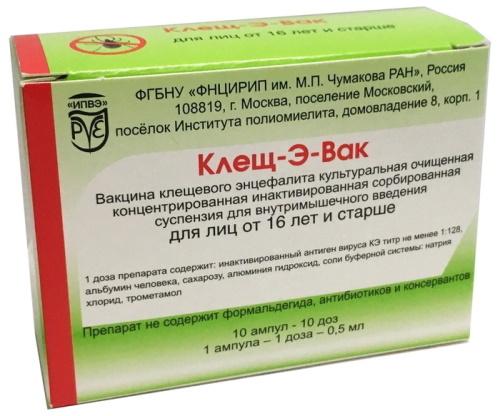
The use of this drug is contraindicated in the following cases:
- diseases of the central or peripheral nervous system;
- diabetes;
- hematological diseases;
- heart failure;
- bronchial asthma;
- various kinds of allergic reactions to the protein part of a chicken egg;
- hypersensitivity of the body to the active substance of the drug;
- chronic pathologies of the kidneys and liver tissues;
- thyrotoxicosis of the thyroid gland;
- epileptic seizures;
- tumor neoplasms of a malignant nature of origin.
The Mites-E-Vac vaccine is not prescribed for use in patients diagnosed with acute or chronic diseases of inflammatory etiology. At the time of administration of this drug, the human immune system should be in a satisfactory state.
After injection with the Mites-E-Vac suspension, the following symptoms of side effects may be observed in the first 2 days:
- redness of the skin in the area of the injection;
- migraine;
- slight increase in general body temperature and in the area of vaccine administration;
- burning sensation at the injection site;
- general weakness and aches in bones, joints, muscles.
The drug Tick-E-Vac can be used simultaneously with other vaccines, the active ingredients of which are live, or have passed the stage of chemical inactivation. The average cost of this product is from 4059 rubles. for 10 ampoules of 0.5 ml (10 doses).
Tick-borne encephalitis vaccines are drugs for effective prevention of this disease. The carriers of this disease are female ixodid ticks. These vaccines contain antigens that help build a reliable immune defense against the effects of a viral infection.
Routine immunization is carried out in 3 stages with strict adherence to the established schedule. Repeated revaccination is carried out no earlier than 3 years later. Most of the drugs in this group are approved for use in children over 12 months of age. The price for vaccines starts at 900 rubles. for 1 dose.
Tick-borne encephalitis vaccines
Tick-borne encephalitis vaccination:

